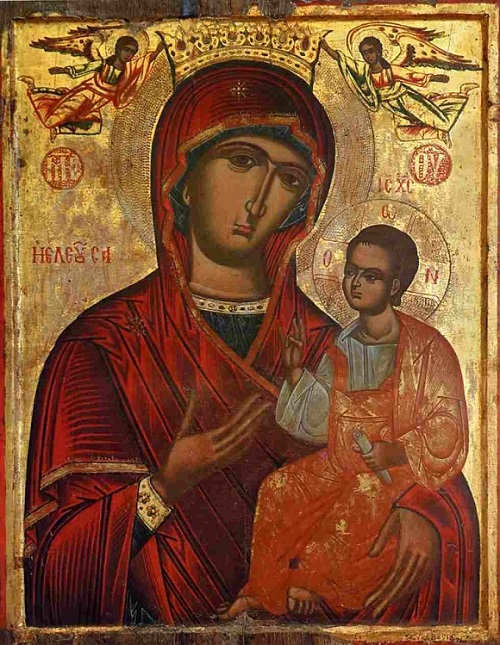The Great Paraclitic Canon
6 August 2020The time from August 1 to 15 is a period in the Church’s year during which the Orthodox soul turns to Our Most Holy Lady the Mother of God, with eyes full of contrition. For the two weeks before the feast of the Dormition, the bells ring at sunset and crowds of the faithful go to sing the Great Paraclitic Canon.
Of course, we have similar contrition during the period of the Salutations to Our Most Holy Lady. But whereas in the Salutations the dominant tone of the hymns is celebration of the limitless qualities of the woman who ‘became the Mother of God’, in the Paraclitic Canon in August the tone is mournful, reflecting the pain of the deeply-suffering faithful, who seek comfort and solace from our Most Holy Lady.
Surely no believer is left unmoved by the wrenching verses of the Great Paraclitic Canon, which speak of the suffering of soul and body. We are not dealing here, however, with the pain of despair, which often leads to unbelief and apostasy. The pain of those who are suffering in God is a pain they recognize as being for their cleansing and uplifting. Because although it saddens and wounds them, it doesn’t alienate them from God, but, rather, brings them to closer knowledge of Him. This is why the pain culminates and also, at the same time, abates, in the following form of supplication: ‘Look down favorably, All-Praised Mother of God, upon the hardship of my body and heal the pain of my soul’.

If you listen to the verses of the Great Paraclitic Canon without paying proper attention, you might say that some anonymous hymnographer was writing a lay about all the common hardships of the soul and body which afflict the faithful. For, indeed, there’s not a Christian who hasn’t repeatedly endured the turmoil of sufferings or hasn’t ever felt many continuous temptations.
It we read it with greater care, however, and delve more deeply into this sacred versification, we’ll see that this is not a description and narrative of people’s tribulations in general in the course of their daily struggle for perfection. The pain and sorrow that befall us produce this heart-breaking cry ‘from life’, ‘at first hand’.
What we have here is an intensely personal drama which was experienced by a known historical person in real, specific conditions. How many of the faithful who sing the Great Paraclitic Canon really know who this person was?
You’d expect the hymnographer of the Great Paraclitic Canon to have been a sensitive female figure, such as Kassiani, or some venerable monk of the desert. Yet he was neither one nor the other of these. The author of this tear-stained hymn was a man at the height of his powers and, moreover, a crowned emperor.
He was the Byzantine Emperor of Nicaea, Theodoros II Laskaris (1222-1258), who, shortly before his death was tonsured a monk and took the name Theodosios. According to his biographers, he was a particularly refined and noble man, who had been fortunate enough to have been given an excellent education, for his era. He lived in very difficult times. The Franks had taken Constantinople, the Bulgarians and the Despotate of Epirus had to be dealt with effectively and the Muslims in Asia Minor were an immediate and permanent threat.
Given his artistic temperament, it was impossible for this tragic emperor to respond to such harsh challenges without serious injury to his health. So it was that he was only 36 when he died.
His life was marked by many inconsistencies, which, of course, were not unprecedented either in the Byzantine Palace or in the upper echelons of society. But herein lies the greatest wonder that Byzantium offers us: that inconsistent behavior in our lives never denies the prospect of eternity and salvation, provided there’s repentance.
At that time, people committed the most horrendous crimes, but thereafter, with rivers of genuine tears, their were cleansed in the eyes of God and of other people.
The whole of the Christian Middle Ages, in both the East and the West differs from the modern world in precisely this aspect. In today’s world people try, from humanism as is claimed- to shape citizens who are law-abiding and honorable, though there is no concomitant interest in their beliefs and their spiritual awareness in general. So it may be that such citizens today are able to avoid direct atrocities in their relationships with others- which in terms of legal process at least certainly makes them more righteous than Christians in the Middle Ages- but such citizens who have been weaned on ‘autonomy’ and ‘autonomous ethics’ have never known the contrition and purification, the repentance and sanctification which tears bring when we recognize our sins.
The question arises: what relationship can such citizens have with the Kingdom of God? We know that Christ declared: ‘I did not come to call the righteous, but sinners to repentance’ (Matth. 2, 17). This means that the Kingdom of God is not inhabited by scrupulous narcissists who have never broken down in the face of the unsearchable mysteries of God, but rather by people reborn through repentance.
Knowing these redeeming truths very well, Emperor Theodoros II described himself as being ‘wounded and pierced by all manner of sorrow’, but did not despair. He believed and was vigilant. He believed and hoped that, through all his vicissitudes, God was preparing his salvation. ‘Nothing has happened to me, I say, but cleansing of the spirit and abasement of the body, so that the Creator can save both’.
May the memory of the blessed Emperor Theodoros II, who taught us the Paraclitic Canon, be eternal.






